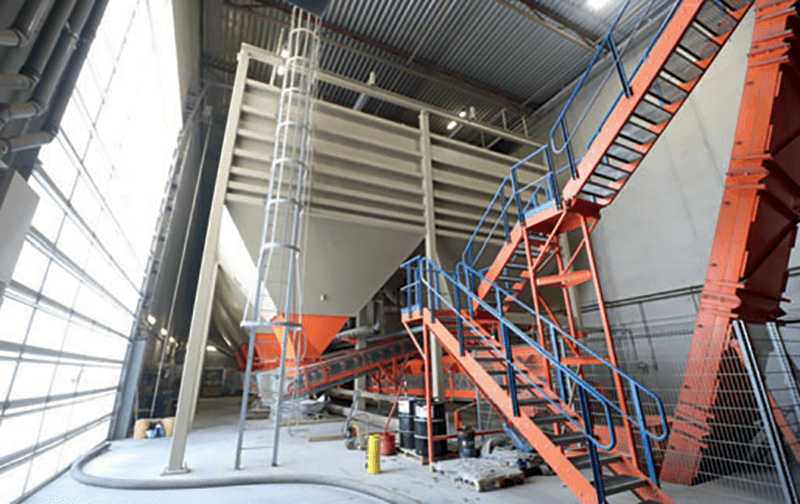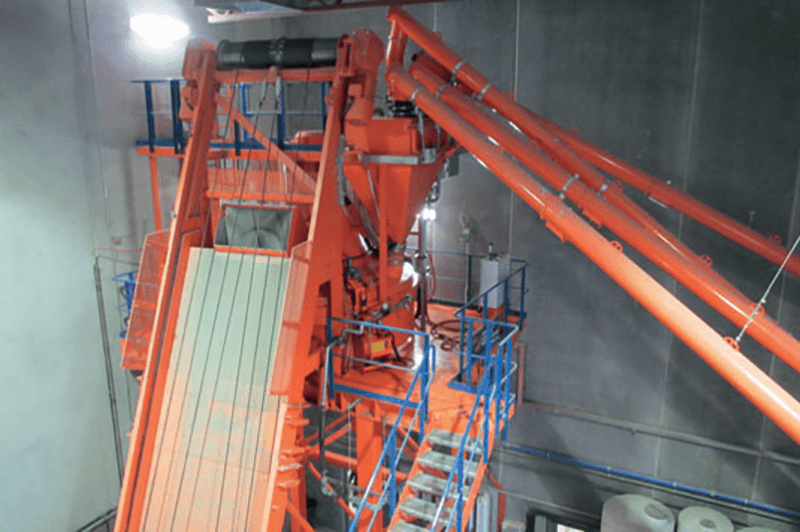Eagle Builders foundation lies in designing and producing precast structures for agricultural markets primarily in Alberta, and extending its reach to commercial and industrial customers across western Canada. Even in the face of two major recessions, one global and one local - Eagle Builders has still increased sales by an average of 25% each year.
This growth has led to three major expansions of its plant in Blackfalds, a relocation, and a new office building. Each new plant expansion has included a mix of new equipment and features that have helped boost efficiency, increase production capacity, introduce new products, and increase quality and consistency.
Eagle's precast products, including double tees, stairs, columns, hollow-core floor and roof panels, architectural classing, and prestressed beams allow them to erect large structures, such as buildings, in week rather than months. This efficient construction is important in this part of Canada, where winters last more than half the year. Even with the ground frozen solid, the precast wall panels are able to be installed on heavy steel pilings, which are driven below the frost line creating a solid foundation.
Growing pains forced Eagle to do a major plant expansion in 2003, which they also outgrew in a few years. They had to double their plant's footprint to accommodate a wider range of product and sizes. Again in 2011, they needed to expand. They considered using their existing concrete batch plant, but an incident caused Eagle to rethink that plan. Co-owner and production director Kevin Kooiker explains, “Our original batch plant had a large skip hoist to lift the aggregates from a conveyor to the mixer. There was a flaw in the cable mechanism and just before the new expansion was completed, the skip hoist came crashing down. We experienced about six weeks of downtime while we worked to get that fixed and had to use ready-mix in the meantime.”
“We knew we needed a bigger mixer,” Kooiker says. “We also realized that with the right batching system we could achieve much more. For instance, with the right system we could introduce the use of SCC and possibly eliminate a lot of the vibrators and even the casting machine we were dependant on with the old batch plant—our old system was incapable of producing reliable SCC.” Kooiker says the firm was already aware of the top batching systems on the market having attended multiple precast shows in North America and Europe. “We received quotes from several companies and met with their representatives,” he notes. “We liked the proposal from Advanced Concrete Technologies (ACT) and the extra value they provided with their experience and design assistance.”
ACT engineers suggested a major reconfiguration for Eagle Builders’ new expansion. The proposed ACT/Wiggert WicoMix 3000-WCS single-mixer batching system would be centrally located and be able to efficiently feed both sides of the production facility via two separate concrete chutes. The cart used with the earlier mixer would be replaced by four crane buckets, two for each production hall.

The improved batch plant would incorporate Eagle’s preexisting cement and concrete silos, as well as the firm’s custom-made aggregate bins. Was it a tight fit maneuvering the new batch plant into the existing structure? “Oh yeah,” says Kooiker. “That was a challenge for sure. With our original plant, the roof was still open and we could just crane the mixer platform into the space. This time, we had a 16’ x 18’ overhead door we had to work through. The new primary aggregate bins and conveyors had to be moved to a new area without crane access, so it all had to be done with forklifts and a picker truck.”
The ACT batch plant installed in 2012 features a high-shear planetary countercurrent ACT/Wiggert HPGM 3000 mixer with two cubic-meter-per-batch output for a total of about 48 cubic meters (63 yd3) per hour continuous production. Aggregate moisture is automatically measured and compensated in real-time with ACT Hydrotester microwave moisture sensors at the bottom of each sand bin and through the PC-based WCS Control system.

Improved batching accuracy and consistency helped Eagle transition to the use of self-consolidating concrete (SCC) for nearly all of its wet cast products, including insulated wall panels, bridge elements, box beams, and other infrastructure components. Eventually, the firm was able to eliminate the large self-propelled casting machine it had used to fill, screed, and vibrate its wall panel beds. “The system was a hindrance to speed and efficiency,” notes Kooiker.
The combination of continuous and consistent production of SCC, the new crane bucket delivery system, and the strategic position of the batching system led to a 15%-20% increase in production efficiency and better overall product quality. “The relocation of the batching system was a huge improvement. We noticed the improvement in concrete quality and consistency right away. We were able to refine our mixes to a greater degree and ultimately began using less admixture and still achieve the same or better compressive strength,” Kooiker says.
As the old saying goes: ‘nothing succeeds like success.’ Eagle Builders’ 2012 expansion met their needs for about three years before the firm began planning its next growth surge. “There was a strong demand for more infrastructure products and hollow-core panels,” Kooiker explains. “The expansion we did in 2016 was strictly for those products. We began doing infrastructure products with our previous expansion and realized we could do much more—bridge girders, modular parking garages, sound barriers, and box culverts. And, we needed hollow-core panels for both flooring and roof structures.”
Kooiker says they carried over many design elements from the previous plant expansion to the 2016 project, with a few exceptions. “We had the old batch plant layout in mind when we were designing the 2016 expansion, that is until we met again with ACT,” he recalls. “Their engineers came up with a configuration for our aggregate bins that ended up saving us space and equipment. We were able to shrink the roof height and length of the building by creating a more compact bin arrangement. We saved nearly $150,000 in building costs.”

“As a leading edge precaster, we are constantly striving to improve our technology and processes to provide the most cost-effective and highest quality product possible.” Kooikersays. “The sophistication and appearance of our plant gives our customers confidence in our capabilities."
What about the future? Every few years seems to bring a new expansion for the young firm. “Our last two big expansions and our move to the two ACT batching systems has enabled us to consistently produce any mix we need,” Kooiker continues. “We can switch easily between dry cast and SCC throughout the day. Our current plant provides us with tremendous flexibility. We are confident we can support any product opportunities that arise, absolutely.”









